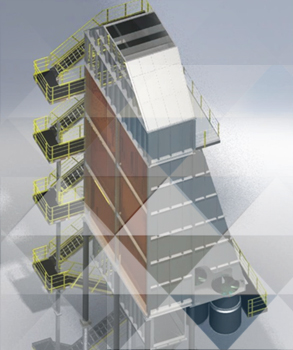Equipments
Heat Exchanger - BOTFAN™

An air-air or air-gas heat exchanger must be installed before the bag filter in order to allow a suitable conditioning of the gas coming from the process. To lower the gas temperature, the concept of forced convection is applied.
Our heat exchangers are designed to lower the temperature of the gas generated by the customer’s process. For this purpose, convection concepts are applied in the sizing and designing so that our equipment can be manufactured with a high degree of efficiency.
Consisting of several tubes through which runs the gas from the customer’s process, where the air goes through a chamber which continuously recirculates it at room temperature, enabling a heat exchange between gas and air through the tube walls. The quantity of pipes determines the area where such exchange will take place, but their number must take into consideration the arrangements set by our technology for an optimal exchange area with as good an ambient air flow as possible.
The speed at which the gas will pass through the pipes is also a very important item to be addressed so that there will be no major load loss (otherwise the fan to be used will increase in price) and to prevent the particulate matter in the gas from sticking to the inner surface of the pipe, which would increase the pressure to be reached by the fan.
The selected pipe layout and flow direction cause part of the particulate matter to be removed at this stage of the filtration process. For this reason, the equipment is fitted with one or more hoppers for storing and discharging such material by means of screw conveyors, rotary valves, slide valves, etc.
One of the most appealing features of this piece of machinery is the ability to reduce the size of the equipment (Bag Filter High or Low-Pressure or Electrostatic Precipitator) to which the outgoing gas will be sent, because the volumetric flow rate of such treated gas will lower than the flow rate at the exchanger intake, while the particulate matter will decrease in volume because part of it was retained on the exchanger hopper.
The decrease in temperature also influences the selection of the bag type to be used for one Filter Bag unit since no specific bag material composition is required for withstanding high temperatures, which substantially reduce the cost of this equipment. In conclusion, many are the cases where using a Heat Exchanger will eventually lower the system’s total cost, which can be set off against the amount saved by reducing the filtering equipment in size and using thousands of bags that are simpler in composition, which is also conducive to lower operating costs.


